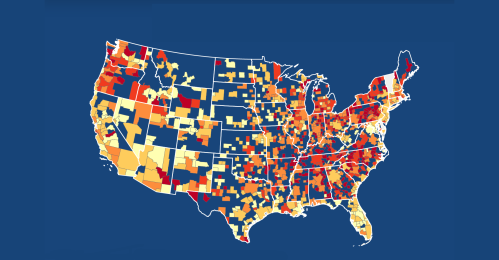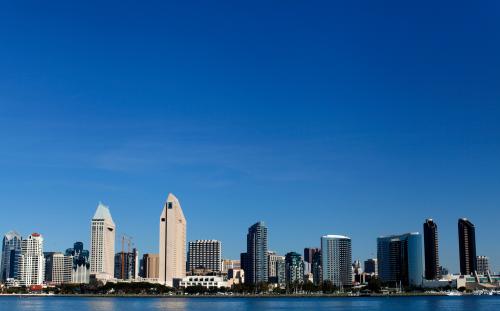In President Trump’s proposed budget, the administration justifies some funding cuts by acknowledging the role of state and local actors, calling them “better positioned to serve their communities,” and designating cut programs as “primarily State and local functions.”
Indeed, states and localities are leading much of the work to ensure America is secure and prosperous. In fact, Trump needs states and regions to be effective partners if his priorities are to benefit communities across the nation. Yet the sizable cuts to non-defense discretionary spending, if adopted, would deliver a severe blow to these state and local allies.
As one mayor expressed to us recently, many local initiatives are in fact national priorities delivered through states and localities because they know how to apply public and private resources most effectively. Furthermore, intergovernmental coordination is increasingly essential on issues such as counterterrorism, trade promotion, and disaster preparedness.
Here are three observations on how the Trump administration’s proposed budget cripples America’s system of integrated governance between federal, state, and local officials:
1. States, local governments, and the private sector cannot absorb cuts to federal aid.
The proposed budget assumes that state and local entities will simply pick up the tab for eliminated programs, including the Low Income Home Energy Assistance Program (LIHEAP), Manufacturing Extension Partnership, and the Small Business Administration’s Regional Innovation Clusters. Yet state and local governments are already stretched thin due to rising Medicaid spending, pension obligations, debt repayments, and other costs. Many local governments have fewer staff than before the recession, and are raising taxes to pay for increased costs in public safety, infrastructure, and social services. Some jurisdictions, including rural areas and older industrial cities, have little access to corporate partners or philanthropies to close funding gaps, as one House Republican from Kentucky articulated recently. Due to limited local budgets and the uneven distribution of private capital, the federal budget cuts will either be passed on to taxpayers in the form of higher state and local taxes, or vulnerable populations will be left without shelter, food, or other critical services.
2. The budget constrains, rather than encourages, local problem-solving and creativity, including the ability to leverage private investment.
Conservatives often deride top-down solutions and government dependence, instead embracing local discretion, flexibility, and private sector capital. Yet many of the programs that best exemplify the latter approach are on the chopping block. HUD’s Community Development Block Grants (CDBG), established by President Nixon, are flexible grants that allow states and cities to leverage additional capital to revitalize low-income areas. CDBG funds projects including economic development, blight removal, infrastructure, and social service facilities, and by formula, 30 percent of CDBG funds are invested in rural areas. The Department of Transportation’s TIGER grants reward inter-jurisdictional collaboration on regionally significant transportation projects using rigorous cost-benefit analysis beyond what most federal projects require. TIGER leverages 3.5 dollars of public and private investment for each grant dollar spent, and even drew praise from DOT Secretary Elaine Chao in her Senate testimony earlier this year. An independent review found that the Department of the Treasury’s Community Development Financial Institution (CDFI) Fund, and the financial institutions it supports, has channeled billions of dollars of private investment into underserved neighborhoods and to low-income and minority borrowers. Lastly, the Department of Commerce’s Economic Development Administration provides funding that is leveraged many times over to support regional innovation and entrepreneurship strategies in communities that have the greatest need, as our colleague Mark Muro noted.
3. The budget would further destabilize “inner cities” and poor households’ path to self-sufficiency.
In his joint address to Congress, Trump reiterated his commitment to ensure that “our neglected inner cities will see a rebirth of hope, safety, and opportunity,” but these federal aspirations will not go far if they undercut state and local efforts to promote opportunity for low-income households. It’s worth noting that two-thirds of American households living below the poverty line have at least one employed adult in a part- or full-time job. Thus reducing poverty and creating safe neighborhoods requires not just aggregate job creation and policing, but also job training, career pathways to better-paying jobs, transportation access to those jobs, and stable affordable housing for low-income Americans. The administration’s budget made large cuts to agencies such as HUD, DOT, and Labor that threaten local efforts on these issues, thereby undermining federal goals of security and economic mobility.
States and localities are eager to reimagine their relationship with Washington. Last month, Governors Terry McAuliffe and Brian Sandoval, Chair and Vice-Chair of the National Governor’s Association, expressed their interest in contributing to federal discussions on tax reform, health care, and other priorities. The bipartisan Chair and Vice-Chair of the U.S. Conference of Mayors, mayors Mick Cornett and Mitch Landrieu of Oklahoma City and New Orleans, respectively, expressed similar interests in working with the Trump administration.
Leaders outside of Washington have ideas for reforming siloed, restrictive federal programs. But eliminating programs that empower local action and forcing states and localities to take on even greater burdens, as this budget does, would hamper progress. The Trump administration would do well to reconsider how to forge partnerships, not just with Congress, but also with governors and local leaders, to promote economic opportunity for all Americans. Otherwise, as we wrote earlier this year, cities and their states must prepare to navigate the structural challenges of our times on their own.







Commentary
Trump’s proposed budget misses an opportunity to empower states and localities
March 17, 2017